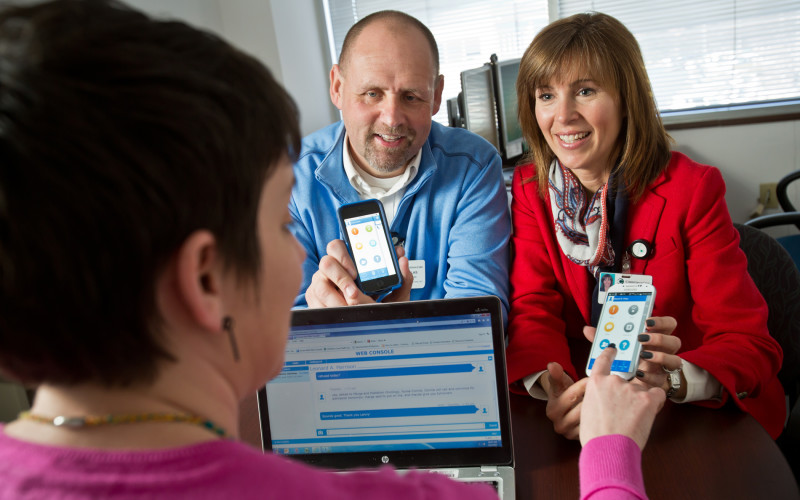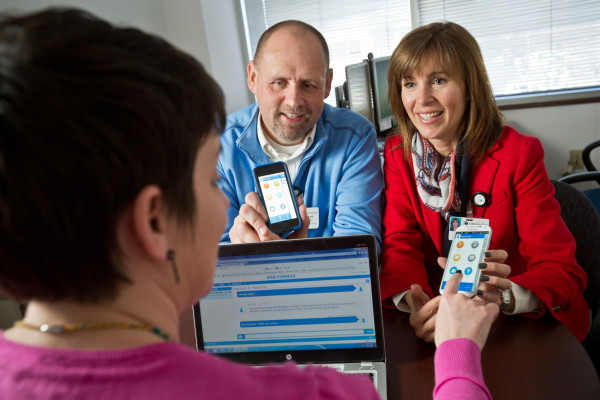New secure messaging system improves staff communications


Early adopters in Christiana Care’s Communications Improvement Project report that a new secure messaging system is fast, efficient and easy to use.
The Vocera Secured Messaging system allows users to send, receive and share texts and images that are compliant with HIPAA regulations. Users can receive and send text messages and alerts via smartphones or a web-based console, eliminating the uncertainty of paging, said Lonie Sculley, project manager, IT.
“A big improvement is two-way messaging, versus one-way paging,” she said. “There’s also a mechanism so users can see if the message was sent, delivered, opened and responded to.”
In a pilot program, 22 members of the Visiting Nurse Association tested the system, a mix of clinicians in the field using smartphones and schedulers on PCs in the office.
“A lot of time we are playing phone tag between our schedulers and our clinicians in the field,” said Jennifer Rittereiser, VNA director. “Secure messaging is much faster and also gets answers to our patients faster.”
The system also allows schedulers to transmit confirmed schedules or send out a group message asking if there is a nurse free to take another case. The latest telemonitoring results can be relayed to nurses en route to patients’ homes.
“Before, we couldn’t do that because we couldn’t use a patient’s name in a text,” Rittereiser said.
Already, the system is showing results, with 58 percent of chats receiving a response in two minutes or less.
“Secure messaging means fewer phone calls to our schedulers, which means fewer calls are going to voicemail,” she said. “That saves the time of listening to the voicemail and calling someone back.”
The ability to securely communicate information about patients is a priority for pulmonologists and intensivists who are called in for consultations, said Natalie Reinbold, the group’s business operations coordinator.
“Physicians can securely communicate, doctor to doctor,” she said. “There’s also a high-alert notification for priority messages.”
In addition to text, images can be sent securely and efficiently.
“If a patient has a skin condition, the hospitalist can send a picture to a dermatologist who may be outside the hospital,” she said.
Anesthesiologists and certified registered nurse anesthetists (CRNA) are among the clinicians who will benefit from technology that eliminates the delays sometimes associated with pages.
“We can text a number of people if we need help in a hurry, said Elias T. Chua, M.D., Department of Anesthesiology. “That will be very useful in emergency scenarios.”
Secured messaging also provides an additional layer of alert in addition to overhead pages, which are not always heard clearly.
“An anesthesiologist may be covering as many as three rooms at a time,” he said. “This helps us to be more efficient in caring for patients, and also adds to patient safety.”
As early adopters, doctors and nurses are providing feedback. Suggestions include tailoring lists to include people in departments rather than everyone with a Vocera account and creating templates for routine messages.
“Our goal is to improve how groups communicate and not simply implement a new tool,” said Karen Gifford, director of Information Technology. “The implementation team will assess current process needs and implement the appropriate features and tools to provide the best communication experience.”
The goal is to enhance communication, which ultimately enhances care. For example, bedside nurses can leverage their existing hands-free Vocera badges.
“Messages sent via the mobile app from a clinician transfers it into a voice message that the nurse at the bedside can listen to,” Sculley said.
Gifford notes that the health system also is working with other vendors such as Apple and Cerner to meet the current and future needs of communication in the most cost-effective manner.
“The future is mobile,” she said. “Don’t be surprised in the coming years when you see clinicians using an iPhone to access clinical information, administer meds, monitor alarms and communicate.”
The Communications Improvement Project team is focusing on two phases. In Phase 1, targeted for June, the current web paging system will be replaced with the new Vocera Web Console. In Phase 2, the mobile app will be upgraded based on input from early adopters. The initial department rollout will focus on those three departments in the fourth quarter of 2015, with Vocera experts on-site to assist.